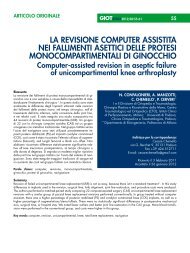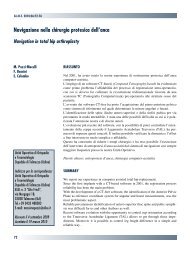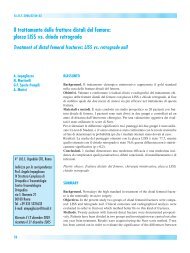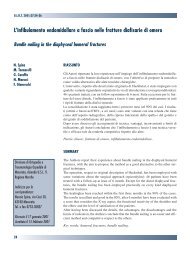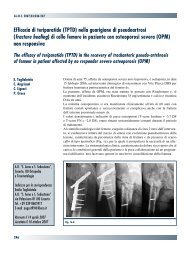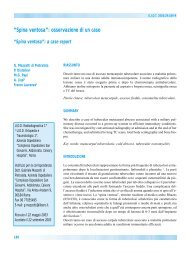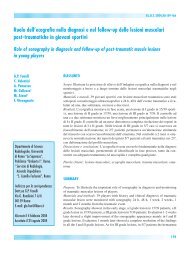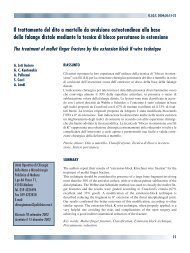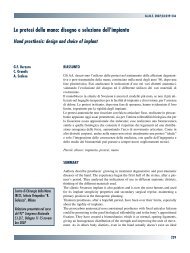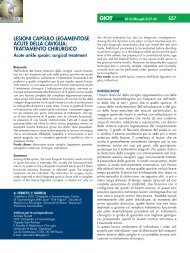30845 Suppl Giot.pdf - Giornale Italiano di Ortopedia e Traumatologia
30845 Suppl Giot.pdf - Giornale Italiano di Ortopedia e Traumatologia
30845 Suppl Giot.pdf - Giornale Italiano di Ortopedia e Traumatologia
Create successful ePaper yourself
Turn your PDF publications into a flip-book with our unique Google optimized e-Paper software.
L’endocrinologo e le malattie del metabolismo osseo<br />
Il metabolismo osseo viene influenzato anche<br />
dagli androgeni. Il 5α-<strong>di</strong>idrotestosterone determina<br />
un aumento <strong>di</strong> IGF-1, il quale stimola la<br />
proliferazione e <strong>di</strong>fferenziazione degli osteoblasti.<br />
Inoltre agiscono sui recettori per l’IGF-<br />
II aumentandone il numero e quin<strong>di</strong> favorendo<br />
l’effetto pro-mitotico dell’IGF-II sugli osteoblasti<br />
e infine determina un aumento della<br />
sintesi e attività del TGF 7 .<br />
La crescita e il rimodellamento osseo subiscono<br />
dei cambiamenti durante le <strong>di</strong>verse fasi <strong>di</strong><br />
crescita. Si è visto che la misura dello scheletro<br />
e il volume della BMD sono simili tra i due sessi in fase pre-puberale;<br />
nel periodo post-puberale si assiste in entrambi ad un aumento<br />
della percentuale <strong>di</strong> crescita e del rimodellamento osseo, con un<br />
picco <strong>di</strong> massa ossea due anni dopo il menarca nella femmina e<br />
nella pubertà avanzata nel maschio 8-12 .<br />
Livelli aumentati <strong>di</strong> GH, IGF-I ed estrogeni durante la pubertà<br />
determinano, nei 3-4 anni <strong>di</strong> crescita rapida, il cosiddetto scatto <strong>di</strong><br />
crescita; gli stessi fattori ormonali si riducono al termine della fase<br />
puberale 13 .<br />
METODI DIaGNOSTICI NELLE MaLaTTIE OSTEO-METaBOLICHE<br />
L’attività cellulare ossea può essere valutata attraverso la determinazione<br />
nel sangue o nelle urine <strong>di</strong> sostanze liberate in circolo<br />
da osteoblasti e osteoclasti in rapporto alle loro attività, che perciò<br />
rappresentano markers specifici dei processi <strong>di</strong> neoformazione o<br />
riassorbimento (Tab. III) 2 .<br />
I markers del turnover possono essere utili per la stima del rischio<br />
<strong>di</strong> frattura (Livello <strong>di</strong> evidenza 2), nel verificare la risposta terapeutica<br />
e la compliance al trattamento 1 . Rispetto alla densitometria,<br />
essi presentano un vantaggio, ossia ridotti tempi <strong>di</strong> attesa necessari<br />
per verificare l’efficacia della terapia anti-riassorbitiva o con PTH,<br />
e uno svantaggio, in quanto sono con<strong>di</strong>zionati dall’ampia variabilità<br />
<strong>di</strong> dosaggio e biologica (Tab. IV).<br />
L’OSSO COME OrGaNO ENDOCrINO<br />
Benché l’osso sia da tempo riconosciuto come bersaglio <strong>di</strong> ormoni<br />
che regolano l’omeostasi fosfo-calcica e la micro-struttura sche-<br />
Tab. III. Principali markers del turnover osseo.<br />
Markers acronimo Dosabile in<br />
Neoformazione<br />
Fosfatasi alcalina totale FA siero<br />
Fosfatasi alcalina ossea FAO siero<br />
Osteocalcina OC, BGP siero<br />
Peptide C-terminale del Procollagene tipo I PICP siero<br />
riassorbimento<br />
Telopeptide N-terminale del procollagene tipo I NTx Urine<br />
Telopeptide C-terminale del procollagene tipo I CTx Urine,siero<br />
Piri<strong>di</strong>noline Pyr Urine<br />
Deossipiri<strong>di</strong>noline DPD urine<br />
S4<br />
Tab. IV. Alterazioni markers nelle principali patologie osteo-metaboliche.<br />
Parametro Osteoporosi rachitismo/<br />
Osteomalacia<br />
Morbo<br />
<strong>di</strong> Paget<br />
Iperparatiroi<strong>di</strong>smo<br />
primitivo<br />
Calcemia N N, ↓ N, ↑ ↑, ↑ ↑<br />
Fosforemia N N, ↓ N N, ↓<br />
Calciuria 24h N N, ↓ N, ↑ N, ↑<br />
Markers neoformazione N, ↑ ↑, ↑ ↑ ↑↑, ↑↑↑ ↑, ↑ ↑<br />
Markers riassorbimento N, ↑ ↑, ↑ ↑ ↑↑, ↑↑↑ ↑, ↑ ↑<br />
PTH N ↑, ↑ ↑ N ↑, ↑ ↑<br />
Vitamina D N, ↓ ↓, ↓ ↓ N N<br />
letrica, stu<strong>di</strong> recenti hanno <strong>di</strong>mostrato che il tessuto osseo stesso<br />
produce almeno due ormoni, Fibroblast Growth Factor 23 (FGF23)<br />
e osteocalcina.<br />
FGF23, prodotta dagli osteociti, è una fosfatonina, cioè un ormone<br />
che agisce a livello renale stimolando l’eliminazione del fosfato e<br />
riducendo la sintesi <strong>di</strong> vitamina D attiva.<br />
L’osteocalcina, secreta dagli osteoblasti, stimola l’increzione <strong>di</strong><br />
insulina da parte delle cellule β pancreatiche e l’utilizzo del glucosio<br />
sui tessuti periferici, con conseguente aumentata sensibilità<br />
all’insulina e riduzione dell’a<strong>di</strong>pe viscerale 14 .<br />
BIBLIOGraFIa<br />
1 Linee guida per la <strong>di</strong>agnosi, prevenzione e terapia dell’osteoporosi,<br />
SIOMMMS 2009.<br />
2 Faglia G, Beck-Peccoz P. Malattie del Sistema Endocrino e del Metabolismo.<br />
Milano: E<strong>di</strong>zioni McGraw-Hill, 2006<br />
3 Braidman I, Baris C, Wood L, et al. Preliminary evidence for impaired<br />
estrogen receptor-protein expression in osteoblasts and osteocytes from<br />
men with i<strong>di</strong>opathic osteoporosis. Bone 2000;26:423-7.<br />
4 Turgeon C, Gingras S, Carriere MC, et al. Regulation of sex steroid formation<br />
by interleukin-4 and interleukin-6 in breast cancer cells. J Steroid<br />
Biochem Molec Biol 1998;65:151-62.<br />
5 Simpson E, Rubin G, Clyne C, et al. The role of local estrogen biosynthesis<br />
in males and females. Trends Endocrinol Metab 2000;11:184-8, 2886-95.<br />
6 Manolagas SC. Birth and death of bone cells: basic regulatory mechanisms<br />
and implications for the pathogenesis and treatment of osteoporosis. Endocr<br />
Rev 2000;21:115-37.<br />
7 Kasperk C, Fitzsimmons R, Strong D, et al. Stu<strong>di</strong>es of the mechanism by<br />
which androgens enhance mitogenesis and <strong>di</strong>fferentiation in bone cells. J<br />
Clin Endocrinol Metab 1990;71:1322-9.<br />
8 Katzman DK, Bachrach LK, Carter DR, et al. Clinical and anthropometric<br />
correlates of bone mineral acquisition in healthy adolescent girls. J Clin<br />
Endocrinol Metab 1991;73:1332-9.<br />
9 Theintz G, Buchs B, Rizzoli R, et al. Longitu<strong>di</strong>nal monitoring of bone mass<br />
accumulation in healthy adolescents: evidence for a marked reduction after<br />
16 years of age at the levels of lumbar spine and femoral neck in female<br />
subjects. J Clin Endocrinol Metab 1992;75:1060-5.<br />
10 Lu P, Cowell CT, Lloyd-Jones SA, et al. Volumetric bone mineral density in<br />
normal subjects, aged 5-27 years. J Clin Endocrinol Metab 1996;81:1586-90.<br />
11 Gilsanz V, Roe TF, Mora S, et al. Changes in vertebral bone density in<br />
black girls and white girls during childhood and puberty. N Engl J Med<br />
1991;352:1597-600.<br />
12 Cadogan J, Blumsohn A, Barker ME, et al. A longitu<strong>di</strong>nal study of bone gain<br />
in pubertal girls: anthropometric and biochemical correlates. J Bone Miner<br />
Res 1998;13:1602-12.<br />
13 Giustina A, Veldhuis JD. Pathophysiology of the neuroregulation of growth<br />
hormone secretion in experimental animals and the human. Endocr Rev<br />
1998; 19:717-797<br />
14 Fukumoto S, Martin TJ. Bone as an endocrine organ. Cell 2009;20:230-6.



